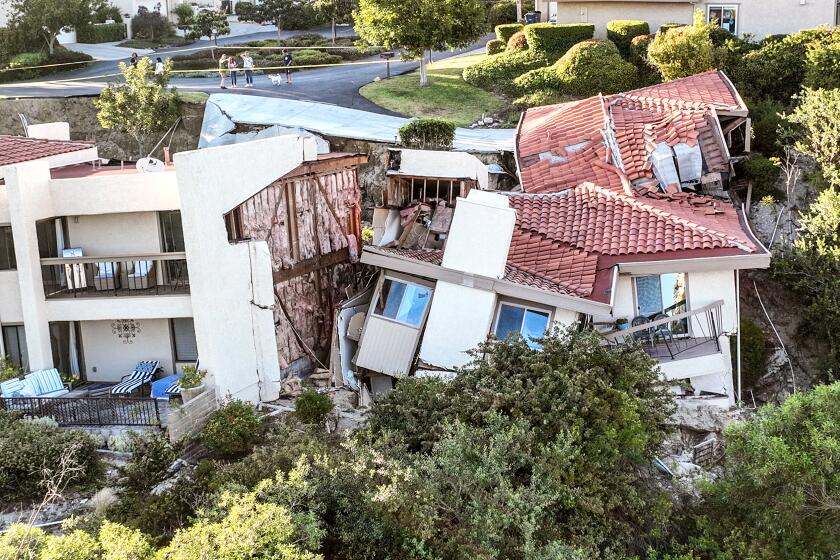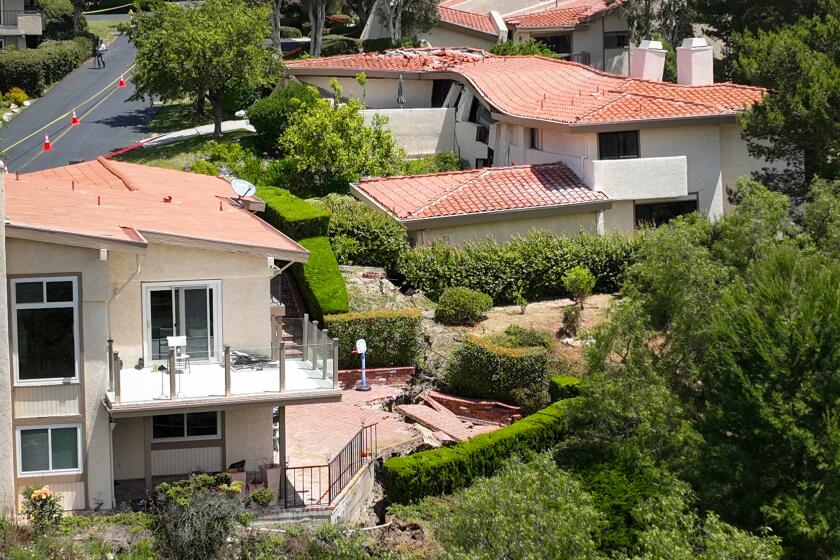Disasters like the Rolling Hills landslide are foreseeable. The warnings are all around us

- Share via
There’s a slow-motion disaster happening this week as houses collapse into a canyon in Rolling Hills Estates, a city in L.A. County. But to scientists who study the geology and climate changes behind this landslide, things seem to be happening all too quickly.
The environment is changing faster now than it has in decades. We are seeing it before our eyes, and especially in the news with reports like Earth’s hottest day ever recorded (July 3, 2023), unprecedented precipitation and severe flooding in California this year, and now a major landslide on ground that was once thought to have stabilized.
What this means is that our understanding of the past — benchmarks that we have long used to guide our preparedness and decision-making about environmental risks — aren’t enough to prepare for the future. In an era of such rapid change, old thinking like the term “100-year flood” becomes almost meaningless.
The Rolling Hills Estates City Council declared a local emergency and said residents whose homes had collapsed had their “support and sympathy.”
Instead, we need to rely on scientific model predictions and forecasts, now more than ever, and even then there will be limitations. Regardless of whether warning signs were missed in the years and days leading up to the Rolling Hills landslide, one thing is certain: There are other alarms flashing all around us, warning of other disasters in the making.
Wildfires are burning with increasing severity and frequency, and we’ve seen entire towns destroyed despite herculean efforts by firefighters. Intense rainfall caused the washout of Interstate 10 in Riverside County, and coastal erosion and cliff instabilities have brought passenger rail service along the coast to a halt. And researchers have recently identified undersized flood channels as a major vulnerability facing Los Angeles, one that could expose more than 400,000 people to severe flooding.
Knowing of a hazard is an excellent start, but we must do more with the information than residents of the Palos Verdes Peninsula did before this most recent collapse. Landslides on the peninsula are foreseeable and have been happening for 67 years. The U.S. Geological Survey even advises that wet winters in particular are a risk factor, and local officials sought to build wells to relieve pressure and reduce the likelihood of collapses. But even with plenty of warning, we failed to prevent this disaster.
Addressing climate change is key to the response to our planet’s many current alarms, and in the meantime we must deal with the new reality. One much-needed mitigation strategy isn’t going to be too popular in California: The rapid change and increasing impacts of natural hazards can be addressed by stepping back from the most hazardous areas.
This can be accomplished through buyouts, for example, with funding from the Federal Emergency Management Agency. Two years ago, state Sen. Ben Allen (D-Santa Monica) proposed a program that would empower California to buy out coastal properties and lease occupancy back to the former owners, but the plan failed to gain sufficient traction in Sacramento. FEMA has also supported giving the most dangerous land back to nature.
Homes in Rolling Hills Estates continued to move Monday morning, more than a day after 12 houses were evacuated because of a major ground shift.
While that would be a loss for some, there are broad benefits to the public, including recreational opportunities, fiscal responsibility and healthier ecosystems. Plenty of land along the California coast is unfit for building but would make for beautiful parkland. Eliminating much of the built environment close to the shore could also help to replenish the sand that Southern California’s beaches are losing because of development.
What will likely be an easier adjustment, one welcomed by communities, is the investment in resilience measures that allow those exposed to natural hazards to limit losses and more easily recover. Our experience with earthquakes can serve as inspiration: The devastating Northridge earthquake in 1994 revealed a pattern of weaknesses in buildings that put us at risk, and following major investments in structural retrofits, millions of people are now safer.
Make no mistake, adapting to a changing climate is going to be tough. But it doesn’t have to involve a lot more scenes like we’re seeing in Rolling Hills this week. We can limit the damage by taking responsible actions now.
Brett Sanders is a professor of civil and environmental engineering, urban planning and public policy at UC Irvine. He leads the UCI Flood Lab and the Metropolitan Beaches Project.
More to Read
A cure for the common opinion
Get thought-provoking perspectives with our weekly newsletter.
You may occasionally receive promotional content from the Los Angeles Times.











